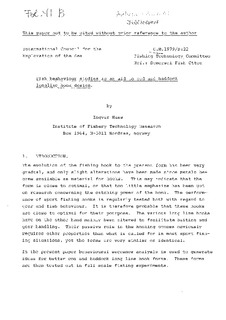| dc.contributor.author | Huse, Ingvar | |
| dc.date.accessioned | 2011-09-06T09:24:46Z | |
| dc.date.available | 2011-09-06T09:24:46Z | |
| dc.date.issued | 1979 | |
| dc.identifier.citation | This report is not to be quoted without prior consultation with the General Secretary. | en_US |
| dc.identifier.uri | http://hdl.handle.net/11250/103353 | |
| dc.description.abstract | The evolution of the fishing hook to the present form has been very
gradual, and only slight alterations have been made since metals became
available as material for hooks. This may indicate that the
form is close to optimal, or that too little emphasize has been put
on research concerning the catching power of the hook. The performance
of sport fishing hooks is regularly tested both with regard to
gear and fish behaviour. It is therefore probable thAt these hooks
are close to optimal for their pourpose~ The various long line hooks
have on the other hand mainly been altered to facilitate baiting and
gear handling. Their passive role in the hooking proces obviously
requires other properties than what is called for in most sport fishing
situations, yet the forms are very similar or identical.
In the present paper behavioural sequence analysis is used to generate
ideas for better cod and haddock long line hook forms. These forms
are then tested out in full scale fishing experiments. | en_US |
| dc.language.iso | eng | en_US |
| dc.publisher | ICES | en_US |
| dc.relation.ispartofseries | ICES CM Documents;1979/B:22 | |
| dc.title | Fish beahaviour studies as an aid to cod and haddock longline hook design. | en_US |
| dc.type | Working paper | en_US |
| dc.subject.nsi | VDP::Agriculture and fishery disciplines: 900::Fisheries science: 920::Fisheries technology: 924 | en_US |
| dc.subject.nsi | VDP::Agriculture and fishery disciplines: 900::Fisheries science: 920::Aquaculture: 922 | en_US |
| dc.source.pagenumber | 12 s. | en_US |
